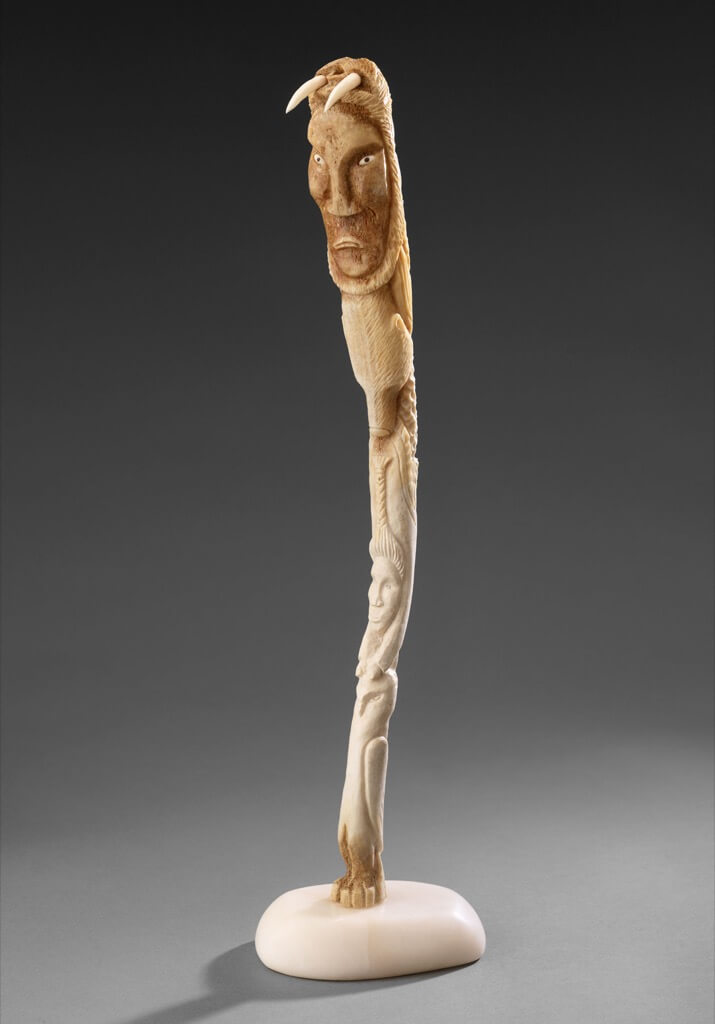Inuit artists turn walrus bones into miniature worlds

Maudie ohiktook’s husband had the same nightmare three times: after killing a seal and hauling it out of the water and onto the sea ice, he would discover to his horror that the seal was, in fact, his wife.
To ease her husband’s distress, Ohiktook, a sculptor living in Taloyoak, Nunavut, carved a likeness of herself with the body of a seal. She presented the figurine to her husband, James, saying, “So this is the seal you used to catch.” He never had the nightmare again.
James has since passed away, but the memory of that healing act continues to inform Ohiktook’s art. Her seal figure, for example, appears in a recent work commissioned by the Walrus Foundation. Ohiktook is one of five Inuit artists who received a walrus penis bone—called an usuaq (pronouced oo-soo-ack)—with the request that she carve whatever she wished on its two-foot-long, slightly curved surface.

Ever since the founders of The Walrus magazine received an usuaq as a gift in 2003, it has functioned as a ceremonial symbol at the foundation. Now, five new usuat will be presented to the foundation’s most generous private supporters, known as Companions of the Order of the Walrus.
Ohiktook’s piece depicts four totem-like figures stacked along the length of the bone, beginning with a small bird at the top end. The creature—which resembles an Arctic tern—represents a turngaq, a shaman’s helping spirit. Ohiktook’s seal figure sits below it, followed by a bird with the face of a woman, and then a man with long fangs that stretch down below his chin. The man is inspired by Kiviuq, a prophet-like figure in Inuit lore; the bird-woman is one of his wives, a snow goose.
While it’s tempting to connect the figures with a single narrative thread—some versions of the legend of Kiviuq, for instance, involve an orphan who turns into a seal—Ohiktook insists their stories are not related. But in a way, they actually are: each figure flirts with controversy. For decades, Christian missionaries and residential schools banned most Inuit tradition, folklore, and spirituality. Even today, the taboos linger. Some Inuit still find references to shamanism sacrilegious.

Ohiktook’s carving also defies a different restriction: for centuries, says John Houston, the filmmaker and dealer of Inuit art who curated this project, market pressures determined what kinds of Inuit carvings could be successfully traded for goods. Long before their work appeared in galleries around the world, Inuit carved small figurines out of stone, bone, ivory, and other materials for trade with whalers and explorers. Often, the visitors sought likenesses of people, animals, and European cultural emblems, such as cribbage boards, and dictated the carvings’ dimensions.
While providing a somewhat lucrative side business for some artists, the demand for little figurines was restrictive: if the carvings didn’t match their clients’ desired parameters, the trade might fall through. That often left little room for creative or abstract ideas, such as, say, depictions of a loved one’s nightmares. “You have people who developed a kind of fear—‘I’ve got to do it just right or there’s going to be nothing for my family,’” says Houston.
The status of Inuit art began to change in the 1950s, when Houston’s late father, James, started to work—first on his own, and then as a representative of the federal government—in what is now Inukjuak, in northern Quebec. It was there that he began leveraging the artistic talent of locals and establishing what would become a vibrant industry throughout the Canadian Arctic. James Houston would go on to help launch the careers of world-renowned sculptors and printmakers, and to elevate crafts such as carving to a higher form of art in the eyes of the Western world—all by encouraging carvers to let their own experiences and creativity guide their work.

Photo by Michael Cullen
“One of the early [Inuktitut] words [my father] learned was isumannit,” says Houston. The term, he says, means “from your own mind,” or simply, “It’s up to you.”
It was the concept that guided John when commissioning carvings for the Walrus Foundation. Like Ohiktook, the other four artists depicted personal experiences and once-verboten legends, defying popular historical restrictions on Inuit art. Adam Alorut’s carving, titled The Fight Between Good and Evil, presents his personal struggle with addiction. In Self-Determination, Manasiah Akpaliapik portrays a hunter in a kayak pursuing a walrus in the open ocean, his harpoon frozen in mid-air—the kind of scene that is vanishing, Akpaliapik says, along with traditional hunting methods.
Mattiusi Iyaituk, a Nunavik artist known for his playful style, and Daniel Shimout, a carver from Coral Harbour, Nunavut, have shaped two vastly different interpretations of the Inuit undersea deity known commonly as Nuliajuk, Sedna, or “The Great One Down There.”

“There was a fear that if you actually mentioned her name, she would suddenly be in the room with you; she would be able to hear everything you were saying,” says Houston, who researched the subject for his 2001 documentary Nuliajuk: Mother of the Sea Beasts. “There was a strict observance of referring to her in many oblique ways.”
But over the past century, the image of Nuliajuk has become associated with a different sort of taboo. “It was convenient for the Christian missionaries because Nuliajuk lived ‘down there,’” says Houston. “They used to project depictions of hell with their magic-lantern slides and would say that she was evil and of the devil.”
Nuliajuk’s image and story have survived in large part thanks to artists and storytellers. While a core trade in iconic figurines still provides Inuit carvers with a reliable income, it’s the more creative work—such as the usuaq carvings—that helps dispel the shame they were once taught to feel. 158034.png
—Samia Madwar
The Usuaq carving project is presented in partnership with TD Bank Group.

